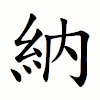納
See also: 纳
| ||||||||
Translingual
| Stroke order | |||
|---|---|---|---|
 | |||
Han character
納 (Kangxi radical 120, 糸+4, 10 strokes, cangjie input 女火人月 (VFOB), four-corner 24927, composition ⿰糹內)
Derived characters
- 㨥 𣻀
References
- KangXi: page 916, character 18
- Dai Kanwa Jiten: character 27264
- Dae Jaweon: page 1345, character 18
- Hanyu Da Zidian (first edition): volume 5, page 3373, character 8
- Unihan data for U+7D0D
Chinese
| trad. | 納 | |
|---|---|---|
| simp. | 纳 | |
Glyph origin
Characters in the same phonetic series (內) (Zhengzhang, 2003)
Phono-semantic compound (形聲, OC *nuːb) : semantic 糸 (“silk, thin thread”) + phonetic 内 ().
Etymology
Pronunciation
Definitions
納
Compounds
Derived terms from 納
|
|
|
References
- “納”, in 漢語多功能字庫 (Multi-function Chinese Character Database), 香港中文大學 (the Chinese University of Hong Kong), 2014–
Japanese
| Shinjitai | 納 | |
| Kyūjitai [1] |
納󠄁 納+ 󠄁?(Adobe-Japan1) |
 |
| 納󠄃 納+ 󠄃?(Hanyo-Denshi) (Moji_Joho) | ||
| The displayed kanji may be different from the image due to your environment. See here for details. | ||
Readings
- Go-on: のう (nō, Jōyō)←なふ (nafu, historical); のう (nō, Jōyō)←のふ (nofu, historical)
- Kan-on: どう (dō)←どふ (dofu, historical)
- Tō-on: な (na, Jōyō †)
- Kan’yō-on: なっ (na', Jōyō †)←なふ (nafu, historical); なん (nan, Jōyō †); とう (tō, Jōyō †)←たふ (tafu, historical)
- Kun: おさまる (osamaru, 納まる, Jōyō)←をさまる (wosamaru, 納まる, historical); おさめる (osameru, 納める, Jōyō); いれる (ireru, 納れる); おさむ (osamu, 納む)←をさむ (wosamu, 納む, historical); おさめ (osame, 納め)
- Nanori: おさむ (osamu); おさめ (osame); もと (moto); のり (nori)
Korean
Etymology
From Middle Chinese 納 (MC nʌp̚). Recorded as Middle Korean 납〮 (náp) (Yale: náp) in Hunmong Jahoe (訓蒙字會 / 훈몽자회), 1527.
Pronunciation
- (SK Standard/Seoul) IPA(key): [na̠p̚]
- Phonetic hangul: [납]
Compounds
Vietnamese
This article is issued from Wiktionary. The text is licensed under Creative Commons - Attribution - Sharealike. Additional terms may apply for the media files.